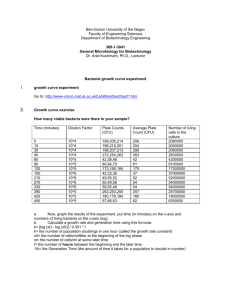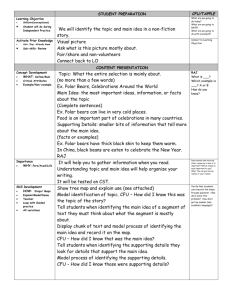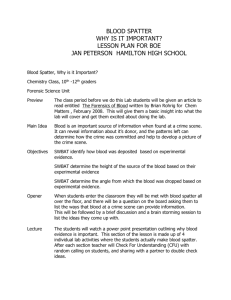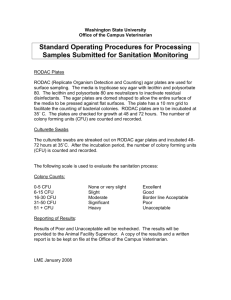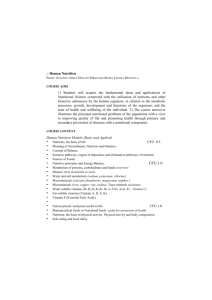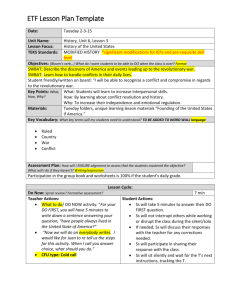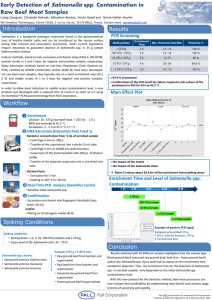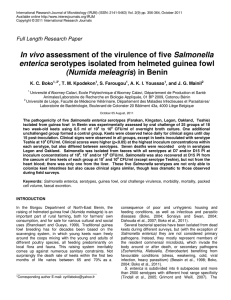Risk Assessment
advertisement
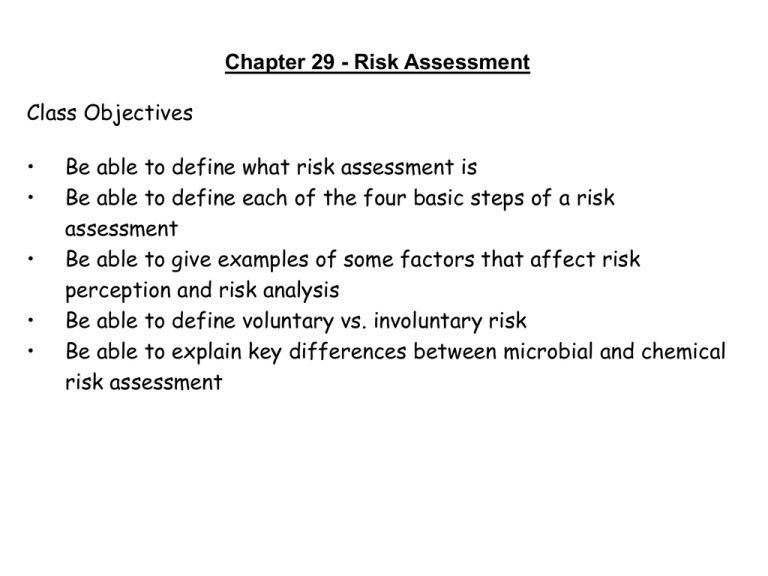
Chapter 29 - Risk Assessment Class Objectives • • • • • Be able to define what risk assessment is Be able to define each of the four basic steps of a risk assessment Be able to give examples of some factors that affect risk perception and risk analysis Be able to define voluntary vs. involuntary risk Be able to explain key differences between microbial and chemical risk assessment What is risk? A controversial but inherent property of everyday life Examples of some commonplace risks in the United States Risk Lifetime risk of mortality Cancer from cigarette smoking (one pack per day) 1:4 Death in a motor vehicle accident 2:100 Homicide 1:100 Home accident deaths 1:100 Cancer from exposure to radon in homes 3:1000 Death from hepatitis A 3:1000 Exposure to the pesticide aflatoxin in peanut butter 6:10,000 Diarrhea from rotavirus 1:10,000 Exposure to typical EPA maximum chemical contaminant levels 1:10,000–1:10,000,000 Even though risk may be relatively low (1:10,000,000) how does one decide what is acceptable risk? A number of factors that affect risk perception and risk analysis: Factor Conditions associated with increased public concern Conditions associated with decreased public concern Catastrophic potential Fatalities and injuries grouped in time and space Fatalities and injuries scattered and random Familiarity Unfamiliar Familiar Understanding Mechanisms or process not understood Mechanisms or process understood Controllability (personal) Uncontrollable Controllable Voluntariness of exposure Involuntary Voluntary Effects on children Children specifically at risk Children not specifically at risk Effects manifestation Delayed effects Immediate effects Effects on future generations Risk to future generations No risk to future generations Victim identity Identifiable victims Statistical victims Dread Effects dreaded Effects not dreaded Trust in institutions Lack of trust in responsible institutions Trust in responsible institutions Media attention Much media attention Little media attention Accident history Major and sometimes minor accidents No major or minor accidents Equity Inequitable distribution of risks and benefits Equitable distribution of risks and benefits Benefits Unclear benefits Clear benefits Reversibility Effects irreversible Effects reversible Origin Caused by human actions or failures Caused by acts of nature Why do we need risk assessment? • Standards for levels of toxic chemicals or pathogenic microorganisms in water or food • Analyses of contaminated sites to determine the need for action and the extent of cleanup • Constructing “what-if” scenarios to compare treatment alternatives and to set priorities for corrective action. • Evaluating existing vs. new technologies • Articulating community public health concerns • Developing consistent public health expectations among different localities Microbial vs. chemical risk assessment There are some inherent differences between microbial and chemical risk assessments. Usually disease due to chemical exposure is cumulative over a long period of exposure. In contrast, for microbes, disease may occur following exposure to a single pathogen and will depend on the virulence of the pathogen and the susceptibility of the host. Therefore, one must estimate a risk of infection based on different factors. (For example, the risk of infection by Pseudomonas aeruginosa is very small in general but is large in a burn unit where burn patients are very susceptible to this opportunistic pathogen. Thus, much more stringent (and expensive) disinfection precautions are taken in the burn unit) Voluntary vs. involuntary risk Voluntary risk (e.g., driving a car) is always more acceptable than involuntary risk (e.g., consuming hamburger contaminated with E. coli). It is generally agreed that a lifetime involuntary risk on the order of 1:1,000,000 is small enough to be acceptable or is a tolerable risk. Risk Assessment Definition: The process of estimating both the probability that an event will occur and the probable magnitude of its adverse effects over a specified time period. Both chemical and microbial risk assessments can be performed. Each consists of four basic steps: 1) Hazard identification - identify the chemical (e.g, lead) or microbial (e.g, Polio virus) contaminant 2) Exposure assessment 3) Dose-response assessment 4) Risk characterization Step 2 - Exposure assessment The process of measuring or estimating the intensity, frequency and duration of human exposures to a chemical or microbe Exposure pathway – the path from a source to the receptor • air • water Exposure route – intake pathway • inhalation • ingestion • absorption through skin Exposure response is mediated by • concentration of chemical/microbe • exposure rate (magnitude, frequency, duration) • receptor characteristics (body weight, genetics, immunity) Event trees simplify modeling the infectivity of a pathogen. The following is an example of an event tree used to estimate the human exposure to Salmonella as a result of biosolids applied to a lettuce crop. Raw sewage 2.9 x 107 CFU/ton Raw sewage sludge 2.4 x 107 CFU/ton Anaerobic digestion 2.4 x 105 CFU/ton Dilution after incorporation into soil 2.4 x 103 CFU/ton Decay in the soil after 5 months 2.4 x 10-2 CFU/ton Amount transferred to lettuce 4.8 x 10-4 CFU/ton Assume 4500 g lettuce consumed/year: Salmonella ingested/person/year 2.1 x 10-6 Salmonella ingested/year Step 3 - Dose-response assessment Quantitating adverse effects from exposure based on the degree of exposure The goal of a dose-response assessment is to obtain a mathematical relationship between the amount of a toxicant/microbe involved in an exposure to the risk of an adverse outcome. To determine the capacity of an agent to cause harm, we need to quantify toxicity or infectivity. Dose – mg chemical/body weight # microbes/exposure Possible responses • no response • temporary response • permanent response • chronic functional impairment • death Primary models used for assessment of nonthreshold effects Model Comments One-hit Assumes (1) single-stage for cancer, (2) malignant change induced by one molecular or radiation interaction Very conservative Linear multistage Assumes multiple stages for cancer Fits curve to the experimental data Multihit Assumes several interactions needed before cells becomes transformed Least conservative model Probit Assumes probit (lognormal) distribution for tolerances of exposed population Appropriate for acute toxicity; questionable for cancer Lifetime risks of cancer derived from different extrapolation models Model applied Lifetime risk (mg/kg/day) of toxic chemical One-hit 6.0 × 10−5 (1 in 17,000) Multistage 6.0 × 10−6 (1 in 167,000) Multihit 4.4 × 10−7 (1 in 2.3 million) Probit 1.9 × 10−10 (1 in 5.3 billion) Step 4 - Risk characterization Estimating the potential impact of a contaminants based on the severity of its effects and the amount of exposure. If one looks at the four steps of risk assessment, there is uncertainty associated with each step of the assessment. The various sources of uncertainty include: • extrapolation from high to low doses • extrapolation from animal to human responses • extrapolation from one route of exposure to another • limitations of analytical methods • estimates of exposure In addition, one must consider vulnerable populations that may be impacted differently than the general population by the outcome of a risk analysis. Uncertainty can be assessed using • sensitivity analysis – the uncertain quantities of each parameter are varied to find out how changes affect the final risk estimate. • Monte Carlo simulation – assumes that all parameters are random or uncertain. The computer chooses random variations of the parameters and generates risk estimates. The final phase of risk assessment is to integrate exposure and dose-response assessments to yield probabilities of effects. Risk analysis can be quite accurate but most risk analysis is associated with a great deal of uncertainty. Example: Infectious hepatitis and viral gastroenteritis are caused by consumption of raw or, in some cases, cooked clams and oysters. The concentration of echovirus 12 was found to be 8 plaque-forming units (PFU) per 100 g in oysters collected from coastal New England waters. What are the risks of becoming infected and ill from echovirus 12 if the oysters are consumed? Assume that a person usually consumes 60 g of oyster meat in a single serving: It has been found that a modified exponential model works well for microbial risk assessment: P = 1 – (1 + N/β)- where: P is the probability of infection, N is the number of organisms ingested, and and β are parameters characterizing the host-virus interaction from the dose-response curve. For this example, = 0.374, β = 186.69, these parameters were estimated from ingestion studies for echovirus 12. Recall there are 8 PFU/100 g oyster and 60 g are consumed: N = 4.8 PFU consumed Using this model for this example: P = 1 (1 + 4.8/186.69)-0.374 = 9.4 x 10-3 If the percentage of infections that result in risk of clinical illness is 50%, then the risk of clinical illness is: Risk of clinical illness = (9.4 x 10-3)(0.50) = 4.7 x 10-3 If a person consumes oyster 10 times a year with 4.8 PFU per serving, then one can calculate the risk of infection in 1 year: Annual risk = PA = 1 – (1 – 9.4 x 10-3)365 = 9.7 x 10-1 Example 2 Comparison of outbreak data to model predictions for assessment of risks associated with exposure to Salmonella Food Water Dose CFU 17 Amount consumed 1 liter Attack rate (%) Predicted P (%) 12 12 Pancretin 200 7 doses 100 77 Ice cream 102 1 portion 52 54 Cheese 100–500 28 g 28–36 53–98 Cheese 105 100 g 100 >99.99 Ham 106 50–100 g 100 >99.99 Risk assessment provides an effective framework for determining the relative urgency of problems and the allocation of resources to reduce risks. Risk assessment is used routinely to make decisions by: • FDA (Food and Drug Administration) • OSHA (Occupational Safety and Health Administration) • EPA (Environmental Protection Agency) These agencies use risk assessment in a variety of situations: • Setting standards for chemical or pathogens in water/food • • • • • • • Assessing risk from GEMS (genetically engineered microbes) Conducting baseline analysis of contaminated sites to determine need for cleanup Cost/benefit analysis Development of cleanup goals Constructing “what if” scenarios Evaluation of existing and new technologies for pollution prevention and control Articulation of public health concerns
